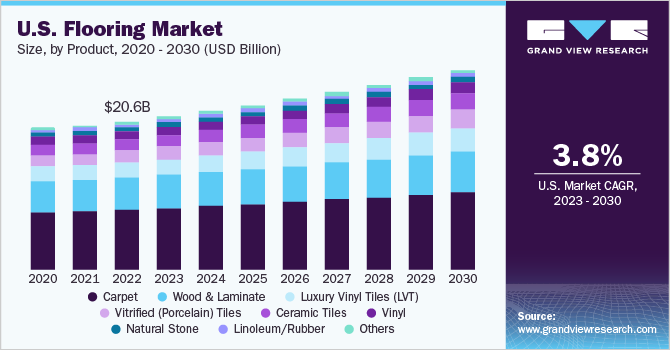U.S. Flooring Market 2030: How Consumer Preferences are Evolving
The U.S. flooring market was valued at USD 20.56 billion in 2022 and is anticipated to grow to USD 27.66 billion by 2030, reflecting a compound annual growth rate (CAGR) of 3.8% from 2023 to 2030.
U.S. Flooring Market Overview
The U.S. flooring market was valued at USD 20.56 billion in 2022 and is anticipated to grow to USD 27.66 billion by 2030, reflecting a compound annual growth rate (CAGR) of 3.8% from 2023 to 2030. Market growth is being driven by increasing demand for flooring solutions that combine durability with aesthetic appeal, such as ceramic tiles, wood, and carpets that also provide insulation benefits. In addition, growing investment in the renovation and remodeling of older homes is playing a pivotal role in market expansion.
Consumer preferences are shifting toward modern, energy-efficient buildings with enhanced aesthetics and integrated technologies, supporting the rise in demand for wood, ceramic, and carpet flooring in residential spaces. The growing adoption of green buildings, fueled by awareness of energy efficiency and indoor air quality, is encouraging sustainable construction practices. This trend is particularly beneficial for wood flooring, which offers low volatile organic compound (VOC) emissions.
Order a free sample PDF of the U.S. Flooring Market Intelligence Study, published by Grand View Research.

Key Market Trends and Insights
- Product Segment: In 2022, carpet led the market with a 40.6% share of total revenue. Carpets are typically made from synthetic and natural fibers including wool, nylon, acrylic, polyester, and polypropylene. Synthetic fibers dominate the category, accounting for over 90% of materials used in carpet production. Among these, nylon alone represents more than 50% of the total raw material share.
- End-Use Segment: The residential sector held the largest share of the market in 2022 at 51.7%. Factors such as rising domestic and international migration and ongoing urban development are expected to bolster demand for residential flooring solutions across the U.S.
Market Size and Forecast
- 2022 Market Size: USD 20.56 Billion
- 2030 Forecasted Size: USD 27.66 Billion
- CAGR (2023–2030): 3.8%
Competitive Landscape
The U.S. flooring market is highly competitive, featuring a mix of regional and global players. Companies are prioritizing product quality improvement and manufacturing capacity expansion. Environmental sustainability has also become a central focus, with manufacturers adopting greener production methods.
For example, in March 2023, Shaw Industries Group, Inc. partnered with Encina to recycle waste produced during carpet manufacturing. Shaw will supply over USD 2.5 million worth of waste annually to Encina, which will help the company reduce its carbon footprint and greenhouse gas emissions, thereby advancing its sustainability goals.
Key Market Players:
- Mohawk Industries, Inc.
- Tarkett
- Forbo Flooring North America
- Interface, Inc.
- EGGER Group
- LG Hausys, Ltd.
- Shaw Industries Group, Inc.
- Mannington Mills, Inc.
- Armstrong Flooring
- Gerflor
- Polyflor Ltd.
- Porcelanosa
- Milliken & Company
- Beaulieu International Group
- Congoleum
Explore Horizon Databook – The world's most expansive market intelligence platform developed by Grand View Research.
Conclusion
The U.S. flooring market is poised for steady growth through 2030, driven by the increasing demand for stylish, durable, and energy-efficient flooring options in both new constructions and remodeling projects. The rise of sustainable construction, particularly green buildings, is expected to fuel the adoption of wood flooring due to its eco-friendly properties. As competition intensifies, major players are innovating and embracing sustainability, which will continue to shape the future landscape of the industry.